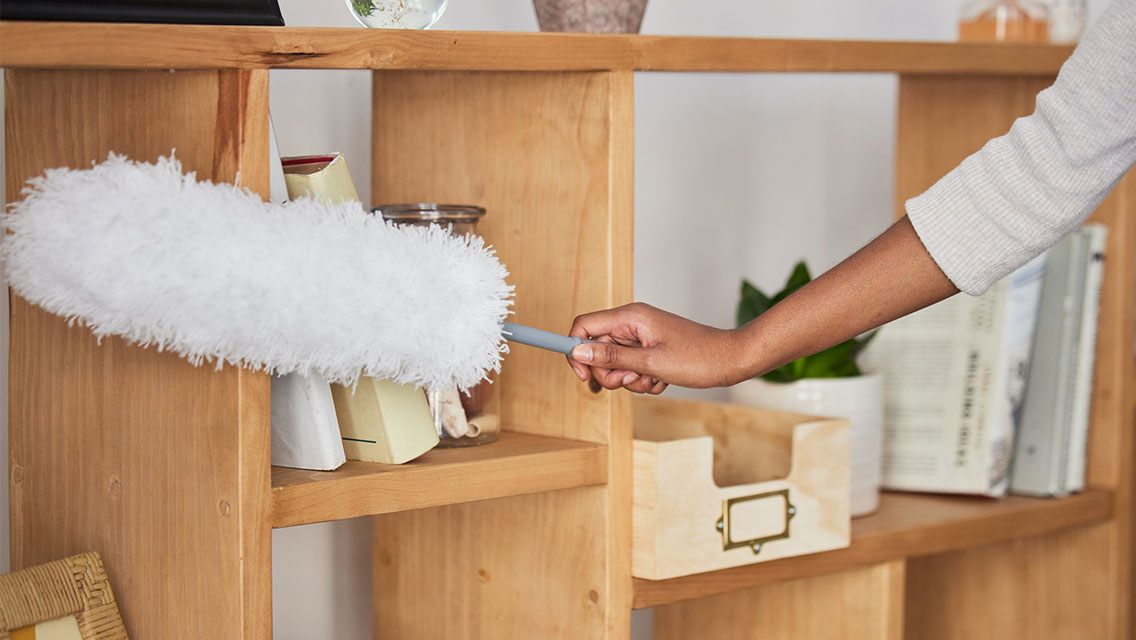Check insulation. Caulk cracks. Seal outlets. You may also want to add cleaning the air to your pre-winter to-dos.
Great, you might be thinking. Now I have yet another chore — and an invisible one at that.
We spend 90 percent of our time indoors, and household air can contain two to five times higher concentrations of some pollutants than outdoor air, according to the Environmental Protection Agency (EPA). Simple everyday tasks that you might not think twice about can pollute the air in your home. And poor indoor air can lead to symptoms including headaches, trouble concentrating, asthma, and fatigue.
The most frequent indoor-air pollutants include:
- Tobacco smoke.
- Volatile organic compounds (VOCs) from paints, air fresheners, cleaners, personal-care items, hobby supplies, and cooking.
- Exhaust or leaks from appliances and heating and cooling systems.
- Offgassing from building materials and furnishings.
- Moisture and mold.
- Exterior sources such as radon, pesticides, and outdoor air pollution.
There are easy steps you can take to reduce many of these. “Just like there are whole foods for your body, there are whole foods for your house,” says architect Paula Baker-Laporte, FAIA, of EcoNest Architecture, coauthor of Prescriptions for a Healthy House. “We can eliminate toxins by being mindful of what the home is made of and what we bring into it.”
1. Service Your HVAC
Annual inspection of your heating, ventilation, and air-conditioning system (HVAC) is recommended by the EPA. Change air filters every 60 to 90 days; consider buying them in bulk to make replacement a hassle-free, routine habit.
The EPA recommends cleaning ducts if they are significantly clogged, infested, or have mold growth. “A poorly performed duct cleaning can actually make your air quality worse if debris is stirred up and not removed properly,” says Reed Manke, owner of HepaVac Duct Cleaning in Minneapolis–St. Paul. “It’s important to do your research and hire an expert that will clean your entire HVAC system, including the furnace and truck lines. This will help protect the life of your furnace and significantly reduce dust, allergens, odors, pests, and mold.”
A portable air cleaner is ideal if you need to scrub the air in a specific area of your home, the EPA advises.
2. Air It Out
The easiest thing you can do to improve your indoor-air quality is to simply open your windows. Unless you have a newer home, most residential HVAC and standalone AC units do not pull outdoor air in, so it’s important to allow fresh air in periodically. Even if it’s for only a few minutes a day, that fresh air can significantly dilute pollutants lingering in your space.
When natural ventilation is not feasible, Baker-Laporte suggests investing in a heat recovery ventilator (HRV). This system reduces indoor toxins by bringing fresh air in using the heat in the stale exhaust air to preheat new incoming air.
“HRVs are especially helpful in newer-built, energy-efficient homes where accidental air leakage is greatly reduced,” she says.
Mildew and mold can be a serious issue in your home — and affect your health. If you detect mold, you may need a pro to intervene. (For more on mold, see “It Could Be Mold“.)
3. Skip Pesticides
If you have issues with insects or rodents, pesticides should be a last resort, as ingredients can include VOCs. “Avoid using pesticides inside your house as much as possible and try to use natural remedies such as essential oils,” advises certified indoor environmental consultant Don Paxton, industrial hygienist for Chicago’s Clean Air Sciences, Inc. Traps can be another solution.
4. Plant Some Air Cleaners
To filter air for astronauts cooped up in the orbiting space station, NASA scientists famously found in the 1980s that basic houseplants provided an effective air detox and could even scrub out VOCs. Other studies showed that plants can help prevent seasonal allergies.
Though it requires a mini jungle to produce a measurable difference in air quality, NASA notes the larger and leafier the plant, the better: Astronaut-approved flora include philodendrons, pothos, ivy, and spider plants. (Learn more at “5 Health Benefits of Indoor Plants“.)
5. Snuff Out Fake Scents
They may smell nice, but candles, air fresheners, and scented dryer sheets are not your friends. “Be careful with air fresheners, especially aerosol sprays, plug-ins, and peel-offs, as many are filled with artificial chemicals that release VOCs into your air — some of which could potentially be toxic,” says Paxton.
He recommends using essential oils or naturally scented potpourri for a safer fragrance. (For more on issues with fake scents, see “The Problem With Fake Scents“.)
6. Clean Up Cleaning Products
Some cleaning products are dangerously toxic or contain VOCs that release into the air. And just because something is labeled “natural” or “green” doesn’t make it so: They can still emit harmful toxins — especially if they include fragrances, studies have shown.
There are plenty of safe cleaning products. Look for those certified by Green Seal or the Environmental Working Group, showing they’ve gone through a rigorous, third-party review and are proven safe for your health and the environment. Or you can easily make your own: Find our recipes at “8 Hidden Toxins: What’s Lurking in Your Cleaning Products?“.
Vacuums can also spew out dust, allergens, and other particulates they are meant to collect. A HEPA (high-efficiency particulate air) filter is critical to keeping your air fresh, advises Baker-Laporte.
7. Ventilate While Cooking
Cooking creates emissions that can be hazardous, especially for children and people with underlying medical conditions. According to the 2019 HOMEChem study, even cooking everyday meals can release unwanted VOCs and carbon dioxide (CO2).
Ventilate your kitchen by simply opening windows and using your stove’s exhaust fan. And while gas might be the choice of chefs, electric stoves and ovens don’t emit noxious gases. Finally, always grill outside.
8. Install Gas Detectors
Carbon monoxide (CO) is an odorless gas that can cause health issues and even be fatal at high concentrations. CO can sneak in via fireplaces, gas stoves, generators, and gas space heaters. The EPA advises that anyone with a fuel-burning furnace, stove, or fireplace have it inspected annually.
The Centers for Disease Control and Prevention (CDC) also recommends installing a battery-operated CO detector in your home.
Depending where you live, radon gas can seep up through the earth into your home. A simple tester from the hardware store can indicate whether to have your home mitigated.
9. Research Furniture Purchases
New furniture, carpets, and mattresses often emit a powerful chemical odor, part of the offgassing process.
“Many furniture purchases that require assembly are manufactured in other countries and undergo chemical fumigation for insects and other organisms before entering the United States,” says Paxton. “If a purchase has a distinct smell upon arrival, try to air it out before bringing it in your home.”
Paxton recommends looking for U.S.-made products to reduce chemical exposure, or buying floor models or used.
10. Leave Shoes at the Door
Your shoes collect contaminants like dirt, dust, bacteria, herbicides, and pesticides that can be tracked inside and transferred throughout your house. The simple solution is to have a rule of taking shoes off upon entry.
11. Opt for Air Testing
For peace of mind, you can test your indoor-air quality, especially before purchasing a home or if you suspect serious issues such as mold or radon.
“Beyond visible water damage or mold, signs that you have a bigger air-quality problem include strong odors, allergy symptoms, or feeling unwell in your home,” says Paxton. DIY tests are available, but hiring a certified professional who interprets the data is worth the investment, he says.
This article originally appeared as “Clear the Air” in the November 2021 issue of Experience Life.





This Post Has 2 Comments
Thanks for sharing!
Usually the most effective way to improve indoor air quality is to eliminate individual sources of pollution or to reduce their emissions. Some sources, like those that contain asbestos, can be sealed or enclosed; others, like gas stoves, can be adjusted to decrease the amount of emissions.
Regards,
Albert Epstein | FDP
Thank you for mentioning air duct cleaning! Very often, homeowners ignore this.
Experts advise having your air ducts cleaned every 2 to 3 years. However, homes with pets or children with allergies should have their air ducts cleaned more frequently than the recommended average.